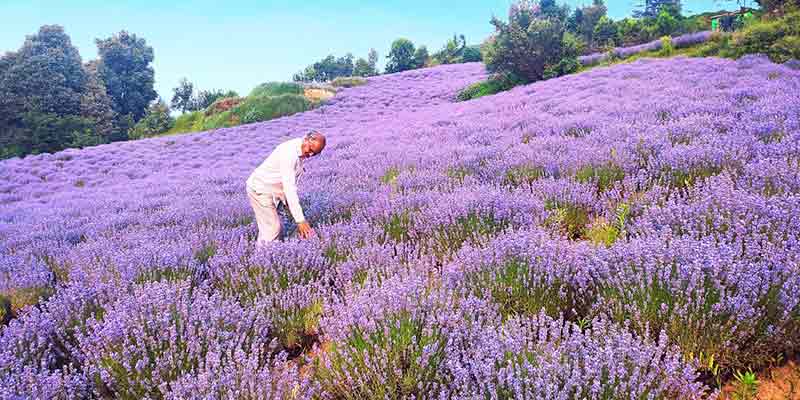Programs and Policies are importance part of Economics and Social Issue, Agriculture and Rural Development section of RBI Grade B and NABARD Grade A Exam respectively. Covering Government schemes directly from source is very much needed but not easy to do, through this article we are solving this problem for you. Read our Programs and Policies related articles on regular basis to gain knowledge about these schemes for RBI Grade B, NABARD Grade A Exam and even for UPSC Civil Service exams.
Union minister Jitendra Singh said that due to high monetary returns, farmers in hilly areas of Jammu & Kashmir are switching from traditional farming to aroma crops like lavender in a big way. The Aroma Mission launched by the ministry of science & technology through the Council of Scientific & Industrial Research (CSIR) has led to the “Purple Revolution” in India.
The minister said that the Centre’s Aroma Mission is changing the mindset of farmers and more and more of them are taking up the cultivation of aroma crops like lavender, lemon grass, rose and marigold for extracting costly oils to be used in many industries. Oils selling about Rs 9,000 per litre are used in making incense sticks and also being used for room sprays, cosmetics and therapeutics.
Last month, Dr Jitendra Singh inaugurated the country’s first ‘Lavender Festival’ at Bhaderwah, which is considered as the birthplace of India’s Purple Revolution. Lavender cultivation has employed about 5,000 farmers and young entrepreneurs in geographically remote areas of J&K. More than 1,000 farming families are cultivating it on more than 200 acres. CSIR is planning to introduce the aroma crops in other hilly states with similar climatic conditions like Uttarakhand, Himachal Pradesh and in northeast statesAroma Mission
The Aroma Mission, also popularly referred as "Lavender or Purple Revolution", has started from J&K and transformed the lives of farmers who are able to grow lavender, make lucrative profit and improve their lives.
The CSIR Aroma Mission is envisaged to bring transformative change in the aroma sector through desired interventions in the areas of agriculture, processing and product development for fueling the growth of aroma industry and rural employment. The income of the farmers through such cultivation is expected to increase by Rs 30,000 to Rs 60,000 per hectare/year.
Objectives:
- To promote the cultivation of aromatic crops for essential oils that are in great demand by the aroma industry.
- To enable Indian farmers and the aroma industry to become global leaders in the production and export of some other essential oils on the pattern of menthol mint.
- To provide substantial benefits to the farmers in achieving higher profits, utilization of waste lands and protection of their crops from wild and grazing animals.
Nodal Agencies:
- The nodal laboratory is CSIR-Central Institute of Medicinal and Aromatic Plants (CSIR-CIMAP), Lucknow.
- The participating laboratories are CSIR-Institute of Himalayan Bioresource Technology (CSIR-IHBT), Palampur; CSIR-Indian Institute of Integrative Medicine (CSIR-IIIM), Jammu etc.
Coverage:
- The scientific interventions made under the mission project provided assured benefits to the growers of Vidarbha, Bundelkhand, Gujarat, Marathwada, Rajasthan, Andhra Pradesh, Odisha and other states where farmers are exposed to frequent episodes of weather extremes and account for maximum suicides.
- Aromatic Plants include lavender, damask rose, mushk bala, etc.
Launch of Second Phase:
- CSIR-IIIM-Jammu announced Aroma Mission phase-II in February, 2021 after the success of the first phase.
- It focuses on setting up of cooperatives for marketing, promotion of cultivation and processing of high value medicinal and aromatic plants (MAPs), development of superior varieties and their agro technologies, setting up of distillation units and processing facilities, skill and entrepreneurship development, value-addition and product development from MAPs.
Significance:
- Apart from being in sync with government policy of doubling farm incomes by 2022, the mission also provided employment to the women farmers thus giving impetus to inclusive growth.
- It is a branch of horticulture that deals with the cultivation, processing and marketing of ornamental plants vis-à-vis landscaping of small or large areas, and maintenance of gardens so that the surroundings may appear aesthetically pleasant.
- To focus on commercial floral crops, seasonal/annual crops, wild ornaments and cultivation of flower crops for honey bee rearing.
- Some of the popular crops include Gladiolus, Canna, Carnation, Chrysanthemum, Gerbera, Lilium, Marigold, Rose, Tuberose etc.
- Indian Council of Agricultural Research (ICAR)
- Khadi and Village Industries Commission (KVIC)
- APEDA and TRIFED
- Fragrance and Flavour Development Centre (FFDC), Kannauj, and
- Ministry of Commerce and Ministry of Micro, Small and Medium Enterprises (MSME).
- The Indian Floriculture market was worth INR 157 Billion in 2018. The floriculture market is expected to reach a value of INR 661 Billion by 2026, exhibiting a CAGR (Compound Annual Growth Rate) of 19.2% during 2021-2026.
- Employment generation: Floriculture has the potential to provide employment to a large number of people through nursery raising, floriculture farming, entrepreneurship development for nursery trade, value addition and export.
- Import Substitution: India has diverse agro-climatic and edaphic conditions (physical, chemical, and biological properties of soil), and rich plant diversity, still it shares only 0.6% of the global floriculture market.
- At least 1200 million USD worth of floriculture products are being imported by India every year from different countries.
Also Read: LiFE Movement- Lifestyle for the Environment
Also Read: Agnipath scheme for Armed Forces
Also Read: What is Jan Samarth portal?
Also Read: Ayushman Bharat Digital Mission and eSanjeevani
Also Read: PM CARES for Children scheme
Also Read: Prime Minister’s Employment Generation Programme (PMEGP)



